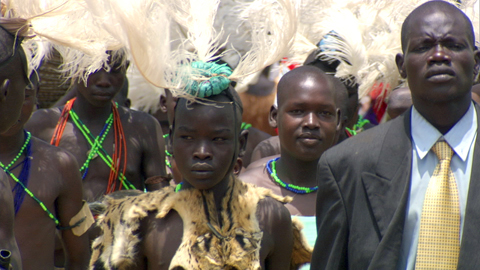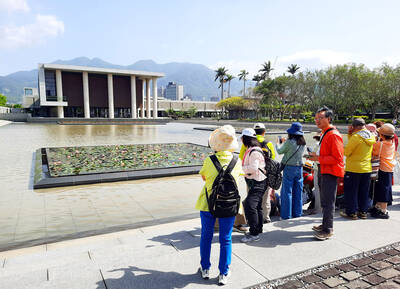War/Dance depicts kids from a war zone who go to the big city to dance for awards. A dancer, a choir singer and a xylophone player share their joy of expression with filmmakers who are just as expressive with their cameras.
Husband-and-wife co-directors Sean Fine and Andrea Nix Fine build a beautiful documentary from elements often favored by nonfiction filmmakers: a hot spot racked with bloodshed, orphans in refugee camps, ravishing scenery and the uplift of watching underdogs onstage vying for the big prize. War/Dance combines all these elements to personalize Uganda’s 20-year civil war and reach transcendence through the perspectives of 13-year-old Rose and 14-year-olds Nancy and Dominic.
“It’s difficult for people to believe our story, but if we don’t tell you, you won’t know,” says Dominic, a xylophonist living in what nongovernmental organizations call an Internally Displaced Peoples Camp, where 60,000 residents are guarded by Ugandan troops. The filmmakers devote little time to life there. Nor do they furnish context for the conflict lasting nearly two decades. Why did “rebels” displace so many civilians in northern Uganda?

Photo: courtesy of cimage
War/Dance, which received an Oscar nomination for best documentary, limits its focus to the personal experiences of three students at the Patongo Primary School inside the camp. In a month, they will board a truck — escorted by soldiers armed with AK-47s — for a two-day trek to the capital city of Kampala for the National Music Competition, the first time this school qualified for the finals. In between rehearsals, we learn the horrific life stories of these three performers from the Acholi tribe. “Since the day we were born, we heard gunshots,” Dominic says.
Four years earlier, Nancy hid in the bush with her young siblings during an attack. Rebels hacked her father apart with machetes, then made her mother pick up his pieces and bury them. When her mother takes her to the overgrown site, Nancy hurls herself on the grave and howls in grief. “This is the bush, Nancy,” counsels her mother. “It’s not safe to cry so loudly here.”
After another attack, Rose asks rebels where her parents are. They point to a pot full of heads. As one of 200,000 orphans in the region, Rose lives a joyless life fetching water, cleaning house, grinding sesame and looking after the children of an aunt who threatens to beat her. Sleep and choral singing are her only escapes.
Everywhere, the threat of physical harm looms. One year, the Lord’s Resistance Army, one of the rebel armies, abducted an estimated 30,000 boys and girls. Dominic managed to escape. Later on, under threat of death, rebels made him beat two farmers to death with their own hoes. “Their legs were kicking, but their heads were not moving,” he tells the camera.
Perhaps helped by the presence of a Western camera crew, Dominic enters the nearby Pader Military Base and asks to meet Sergeant Okello Francis, who was captured from the Lord’s Resistance Army. “Why do the rebels abduct children like me when you know it’s a bad thing?” asks the boy. It’s a wrenching encounter.
Thankfully, Fine and Fine do not play up the movie’s big contest at the National Theatre of Uganda, where 5,000 children dance and sing for three days in eight competitions. Cinematographer Sean Fine shoots over the shoulders of judges, but concocts no phony suspense about the outcome. His keen eye is on the feet and faces of the joyful performers.
Fine’s camerawork — partly inspired by the slick look of films by Michael Mann and Ridley Scott — earned him a Best Cinematography Award at last year’s Chicago International Documentary Film Festival. Dancing between very wide-angle and very long lenses, he frames the aftermath of atrocity with lovely nerve. As one young performer puts it: “You have to be fearless — like a warrior.”

When the South Vietnamese capital of Saigon fell to the North Vietnamese forces 50 years ago this week, it prompted a mass exodus of some 2 million people — hundreds of thousands fleeing perilously on small boats across open water to escape the communist regime. Many ultimately settled in Southern California’s Orange County in an area now known as “Little Saigon,” not far from Marine Corps Base Camp Pendleton, where the first refugees were airlifted upon reaching the US. The diaspora now also has significant populations in Virginia, Texas and Washington state, as well as in countries including France and Australia.

On April 17, Chinese Nationalist Party (KMT) Chairman Eric Chu (朱立倫) launched a bold campaign to revive and revitalize the KMT base by calling for an impromptu rally at the Taipei prosecutor’s offices to protest recent arrests of KMT recall campaigners over allegations of forgery and fraud involving signatures of dead voters. The protest had no time to apply for permits and was illegal, but that played into the sense of opposition grievance at alleged weaponization of the judiciary by the Democratic Progressive Party (DPP) to “annihilate” the opposition parties. Blamed for faltering recall campaigns and faced with a KMT chair

Article 2 of the Additional Articles of the Constitution of the Republic of China (中華民國憲法增修條文) stipulates that upon a vote of no confidence in the premier, the president can dissolve the legislature within 10 days. If the legislature is dissolved, a new legislative election must be held within 60 days, and the legislators’ terms will then be reckoned from that election. Two weeks ago Taipei Mayor Chiang Wan-an (蔣萬安) of the Chinese Nationalist Party (KMT) proposed that the legislature hold a vote of no confidence in the premier and dare the president to dissolve the legislature. The legislature is currently controlled

Dull functional structures dominate Taiwan’s cityscapes. But that’s slowly changing, thanks to talented architects and patrons with deep pockets. Since the start of the 21st century, the country has gained several alluring landmark buildings, including the two described below. NUNG CHAN MONASTERY Dharma Drum Mountain (法鼓山, DDM) is one of Taiwan’s most prominent religious organizations. Under the leadership of Buddhist Master Sheng Yen (聖嚴), who died in 2009, it developed into an international Buddhist foundation active in the spiritual, cultural and educational spheres. Since 2005, DDM’s principal base has been its sprawling hillside complex in New Taipei City’s Jinshan District (金山). But